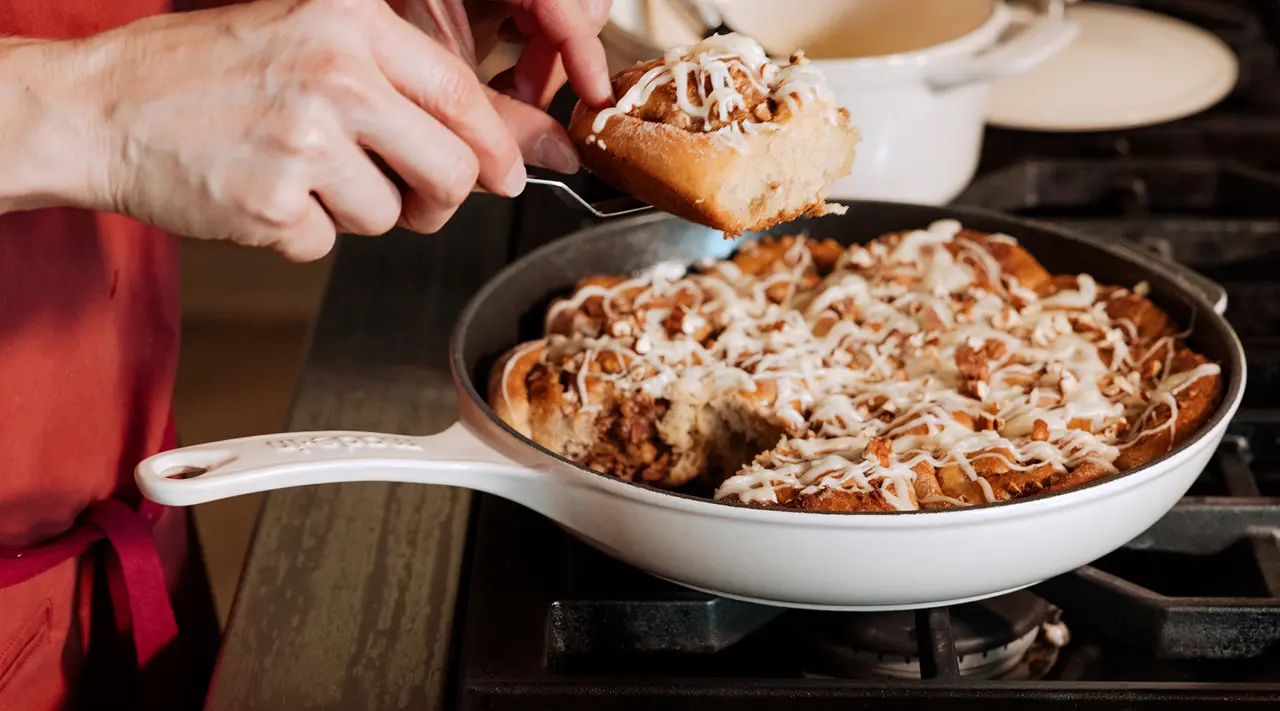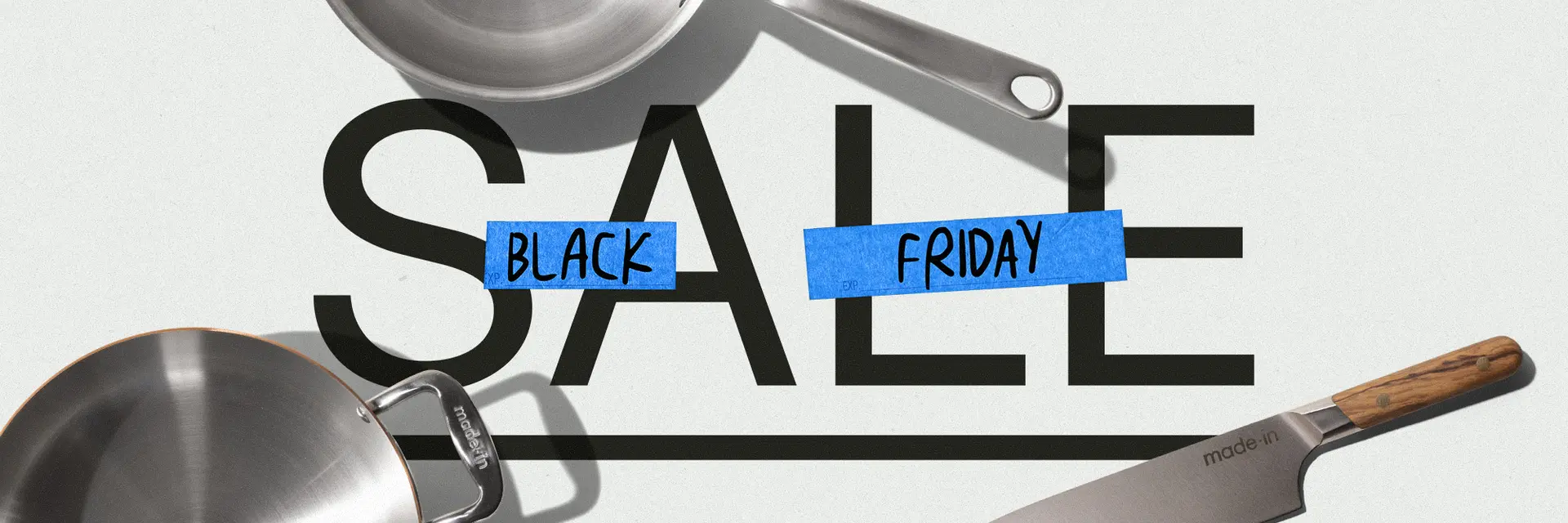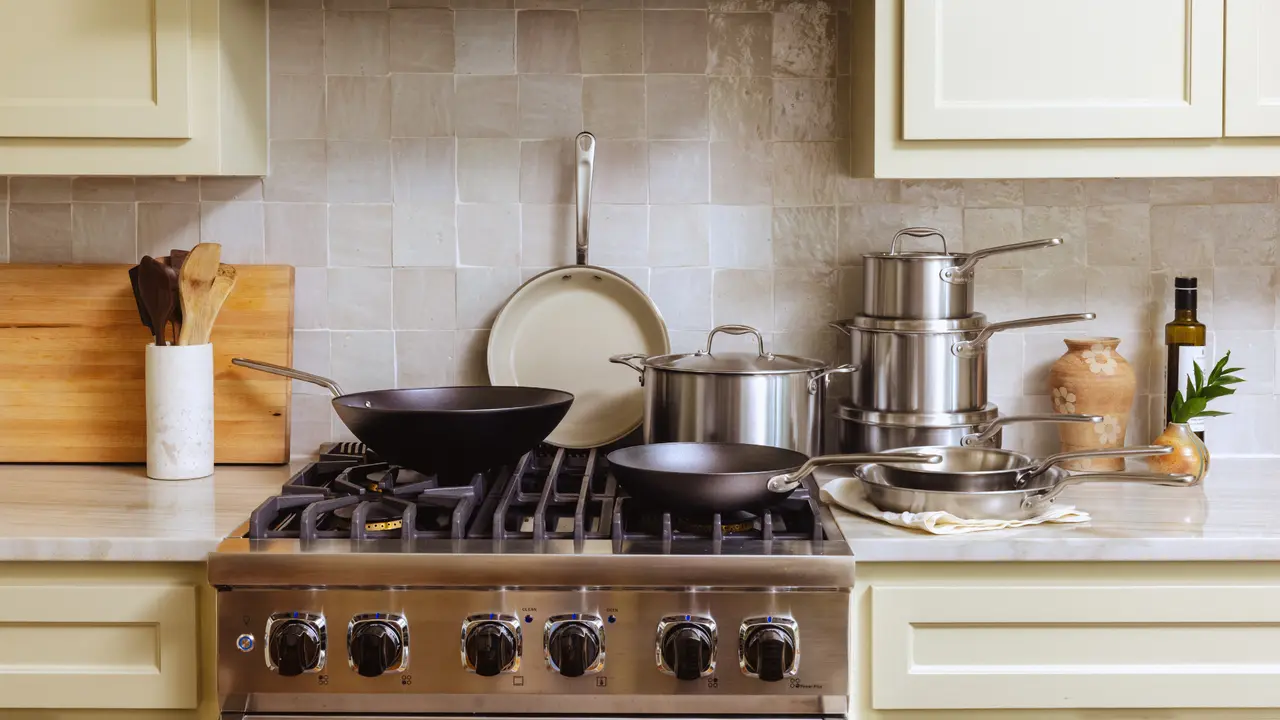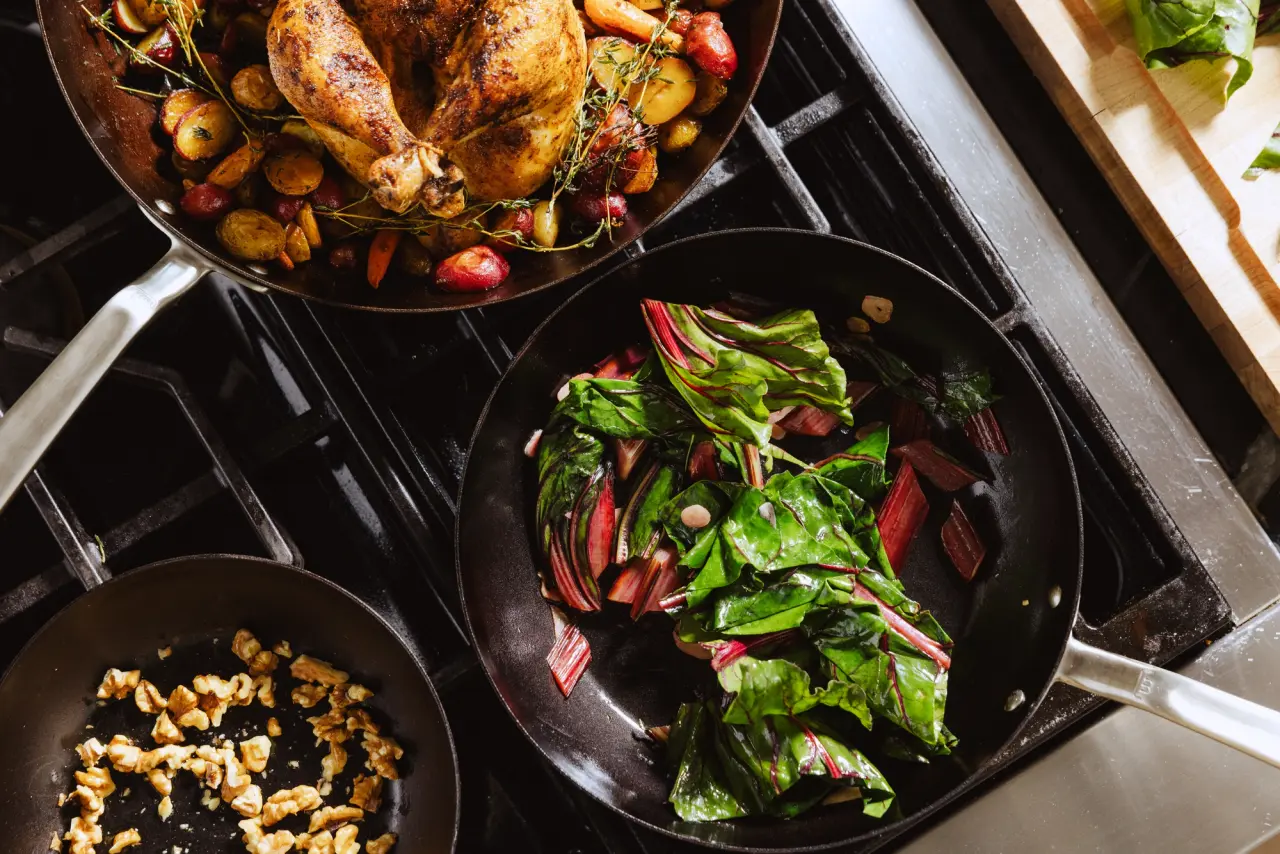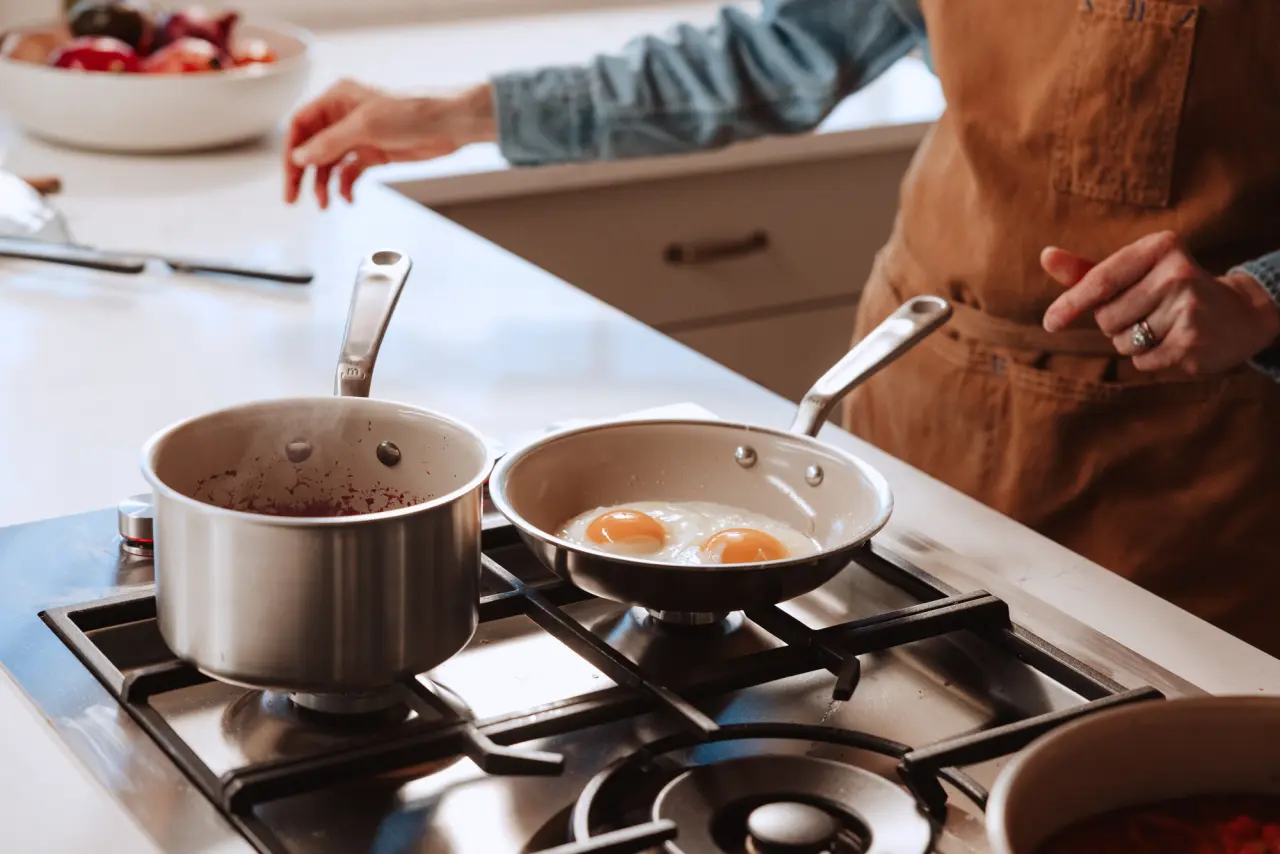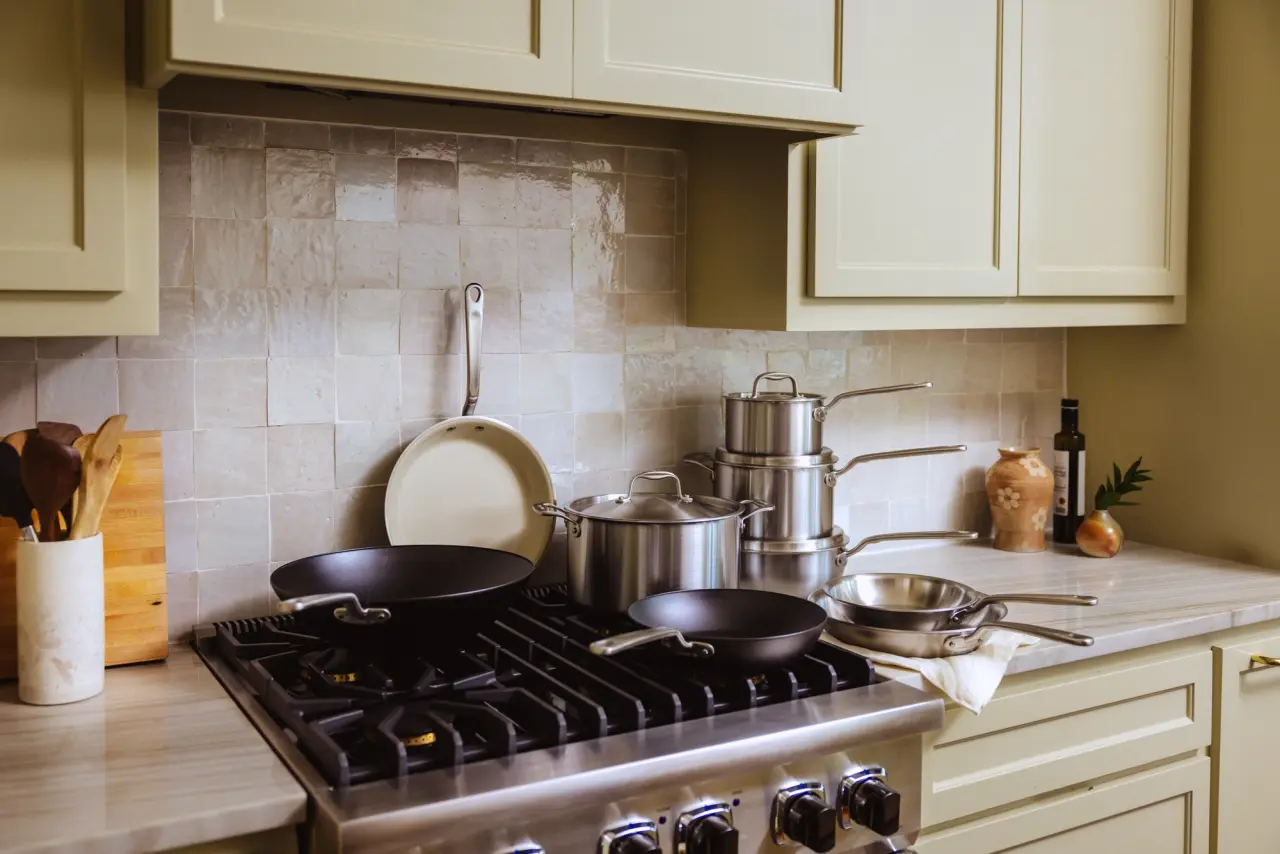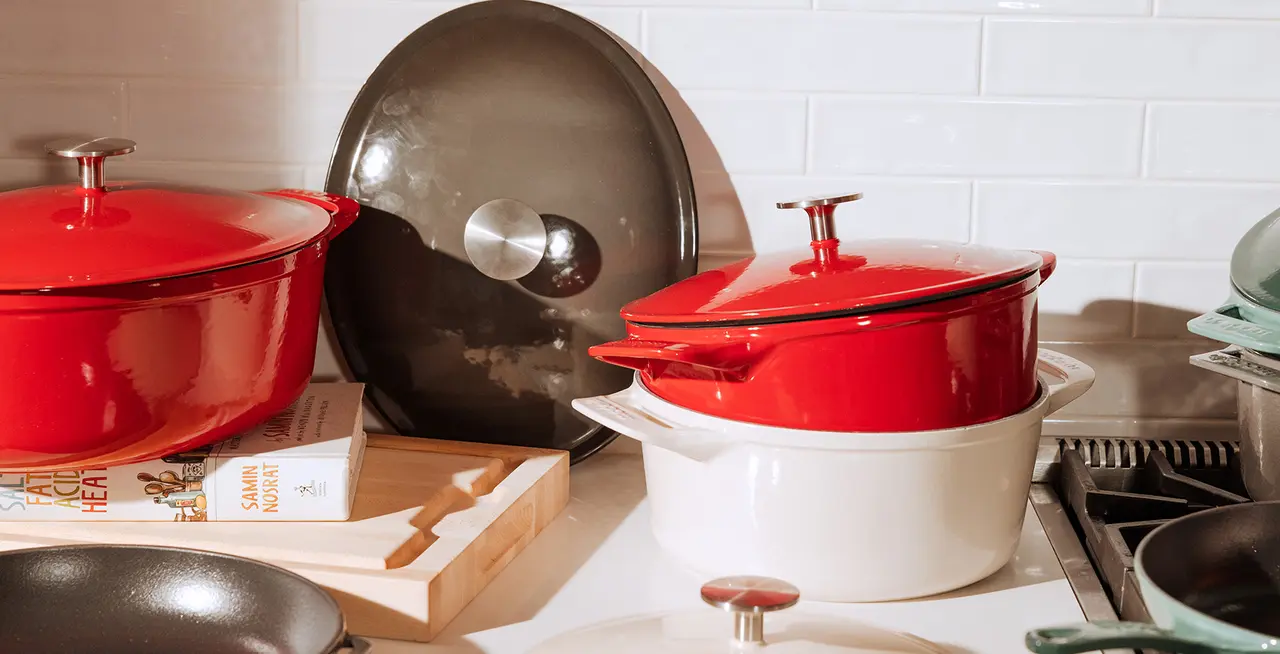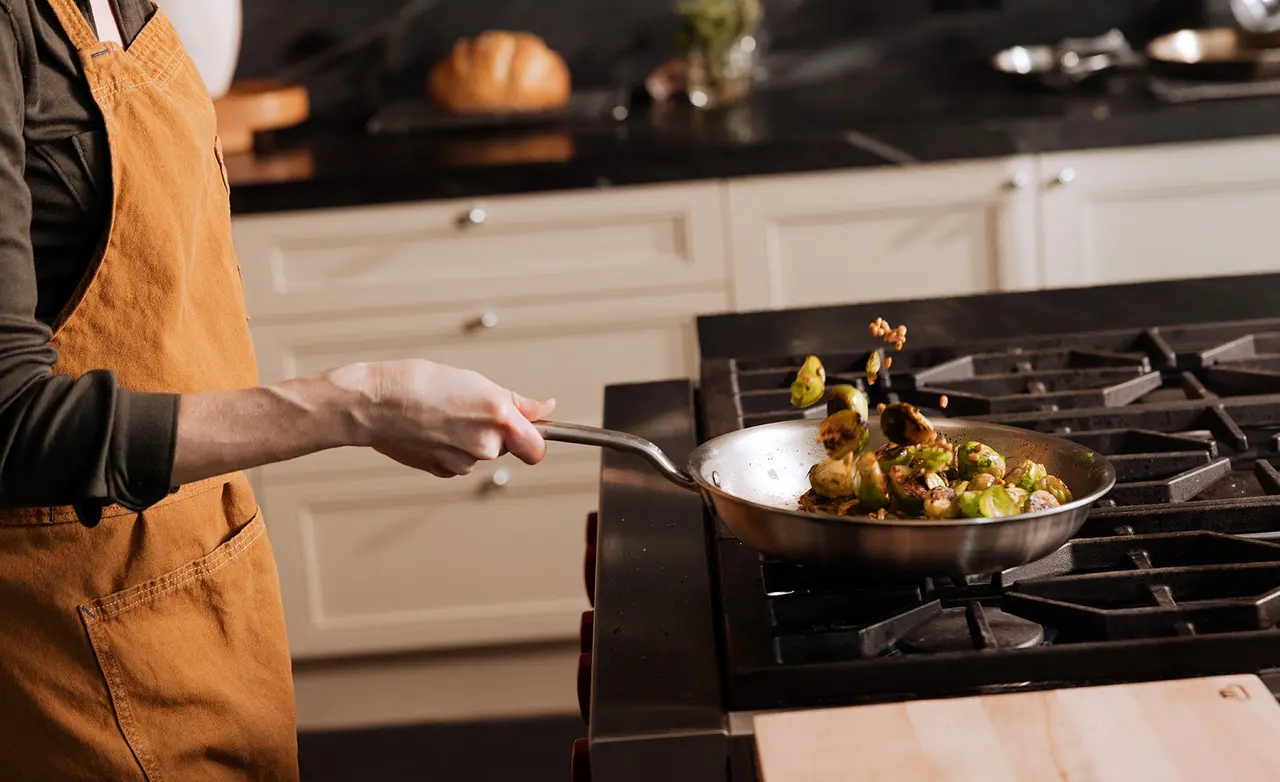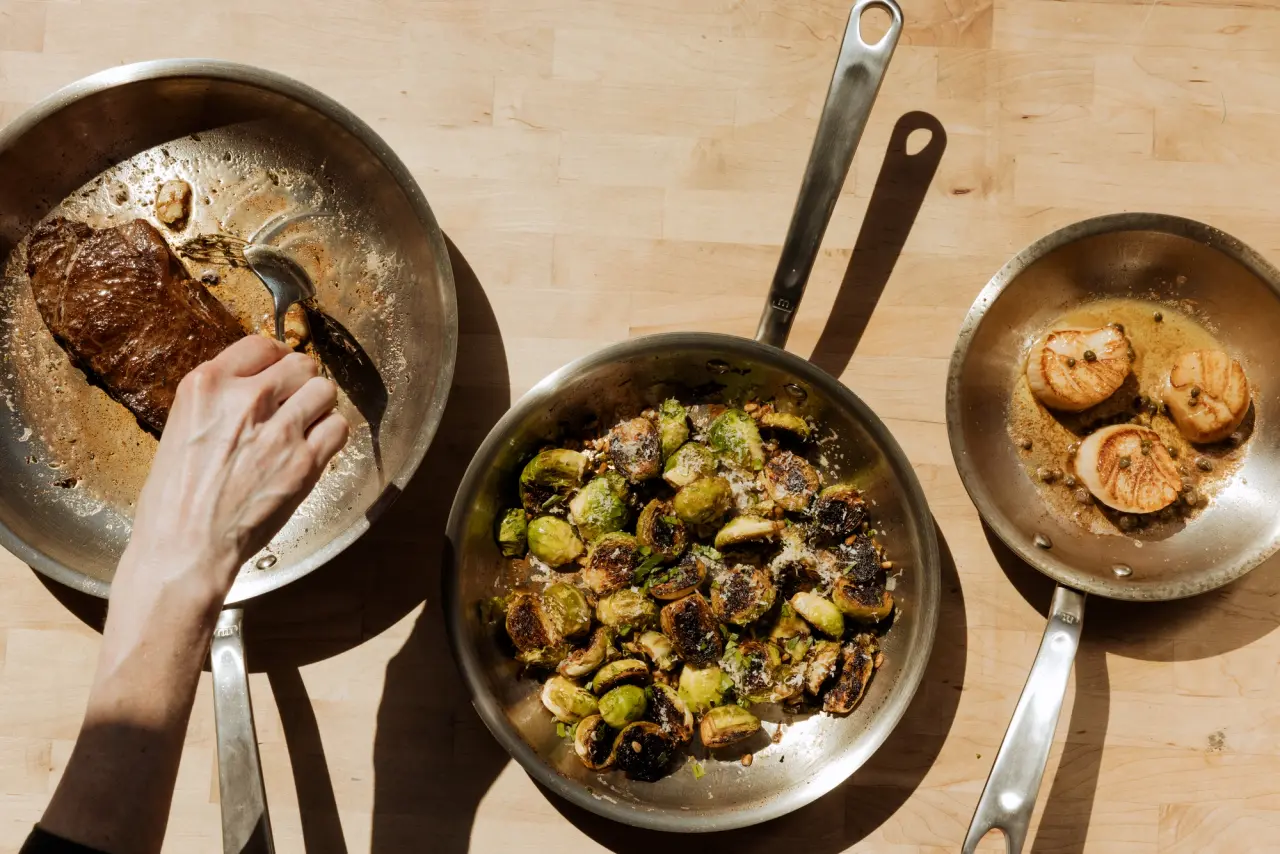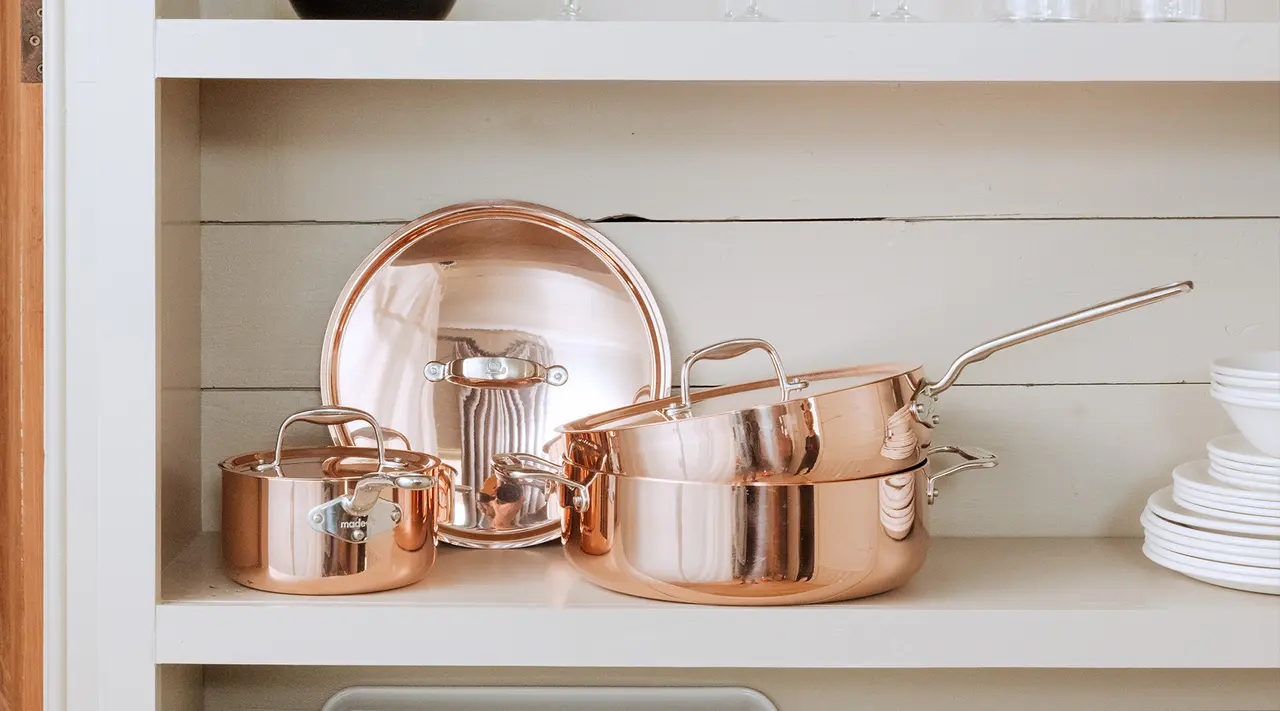Whether you’re just getting started in the kitchen or you’re a professional chef, a high-quality skillet is a must-have for frying eggs, sautéing veggies, and everything in between. Two common choices among home cooks are enameled cast iron skillets and non stick frying pans, renowned for their versatility, no-stick surfaces, and ease of use.
If you're in the same boat and choosing between the two, you may be asking: what’s the difference, and which should you choose? Or, are both skillets needed? It all depends on what you’ll be cooking, and how often. To make matters even more confusing, both can be excellent choices if made from high-quality materials. Here’s how to decide.
Understanding Cast Iron Cookware
If you grew up in the South, chances are you're very familiar with cast iron skillets—and may have a hand-me-down on your stove right this moment.
If not, these pans are poured, shaped, and cast from molten metal that then hardens, making them incredibly durable, generational pieces of cookware. Most cast iron cookware is available in two varieties: enameled cast iron and unfinished cast iron.
Enameled cast iron is coated with a thin layer of enamel, or finely ground porcelain or glass that's fused to the surface, that creates a smooth, non-porous, non-reactive cooking surface. Unfinished cast iron does not have that protective coating, and requires regular seasoning to maintain its non stick properties, similarly to carbon steel.
Both provide the versatility cast iron has become synonymous with, but enameled cast iron is typically easier to cook with and care for.
Advantages of Cast Iron Skillets
Enameled cast iron skillets are a pleasure to cook with because they combine the heating capabilities of cast iron with a smooth, enameled cooking surface. These pans are perfect for searing meats, baking bread, and sautéing everything under the sun. Many appreciate that the skillet can go between the stovetop and oven, perfect for reverse-seared steaks and oven-finished Dutch babies.
- Durability: As cast iron is made from an iron and steel alloy, it's ultra durable and able to be passed down for generations.
- High heat resistance: Cast iron’s extreme durability also extends to its ability to withstand high heat. Our Skillet is safe up to 580F, meaning it can be used for bakes and broils alike.
- Naturally non stick: With proper seasoning, unfinished cast iron develops a frictionless surface made from polymerized oil and becomes naturally non stick. However, if not kept up, the seasoning will wear away, exposing the rough metal beneath and causing sticking. Our enameled cast iron is hand-enameled in France to ensure a smooth finish that does not require regular seasoning, and is non stick out of the box.
Cast Iron Skillet Considerations
Just like any piece of cookware, there are elements of cast iron skillets that require some consideration before purchasing.
- Hot handles: Cast iron is lauded for its ability to conduct and hold heat. However, this does not stop at the handle, which holds heats as well as the rest of the skillet—we recommend handling with care (and an oven mitt or thick dish towel, especially when manuveuring in and out of the oven).
- Weight: While cast iron’s durability cements it as a classic material, it’s significantly heavier than other pans you may be used to handling (including stainless, non stick, and even carbon steel). We added a helper handle to our Skillet for this reason, but cast iron’s weight may be a factor to take into consideration—especially if you’ll be cooking dishes that require quick transitions out of the skillet or oven.
What Is Non Stick Cookware?
The defining feature of traditional non stick cookware, including our ProCoat Non Stick Collection, is its convenient and easy-to-clean non stick coating. This provides a frictionless cooking surface that prevents almost any ingredient from sticking, be it flaky fish or fluffy eggs.
Advantages of Non Stick Pans
Non stick pans are typically constructed from a stainless steel or aluminum base, making them lightweight, versatile pieces to have in the kitchen.
- Ease of use: Non stick skillets are known for being incredibly easy to handle. Naturally, they make cooking stick-prone foods—like pancakes or frittatas—a breeze, and minimize the effort required when it comes to clean up.
- Simple maintenance: Non stick pans require practically no maintenance, great news for anyone who abhors cleaning up after cooking. Simply wipe the pan down and scrub gently with a dish sponge to remove excess food or oil before drying.
- Versatile uses: Made from lightweight materials that conduct heat quickly and evenly, non stick pans are known to be a highly versatile, staple tool for both new cooks and experts, used to cook anything from Dutch babies to lacy-edged fried eggs.
Non Stick Skillet Considerations
While non stick pans surely have their benefits, just like any item, there are factors to keep in mind before purchasing one.
- Heat considerations: Depending on the base or handle material used during manufacturing, many non stick pans aren’t oven-safe. If you’re looking to bake in your skillet or transition a dish from stovetop to oven, you may want to consider a skillet made from a different material. Otherwise, ensure that the non stick pan you’re considering is heat tolerant—for instance, our ProCoat Non Stick Cookware is oven-safe to 500F.
- Lack of durability: Non stick coating is much more delicate than other types of cookware, meaning you need to be aware of your tool choice to maintain the surface. If you use a harder utensil material (like a stainless steel spatula), you run the risk of scratching or even chipping the coating, which could result in a loss of non stick properties.
- Replacements needed: Even the most high-quality non stick pan will eventually lose its coating and need to be replaced. Our ProCoat Non Stick is designed to last for longer than cheaper counterparts, but if you’re looking for a skillet that you'll never need to replace, you may want to consider a different material (like cast iron).
Non Stick vs. Cast Iron: Which One Is Better?
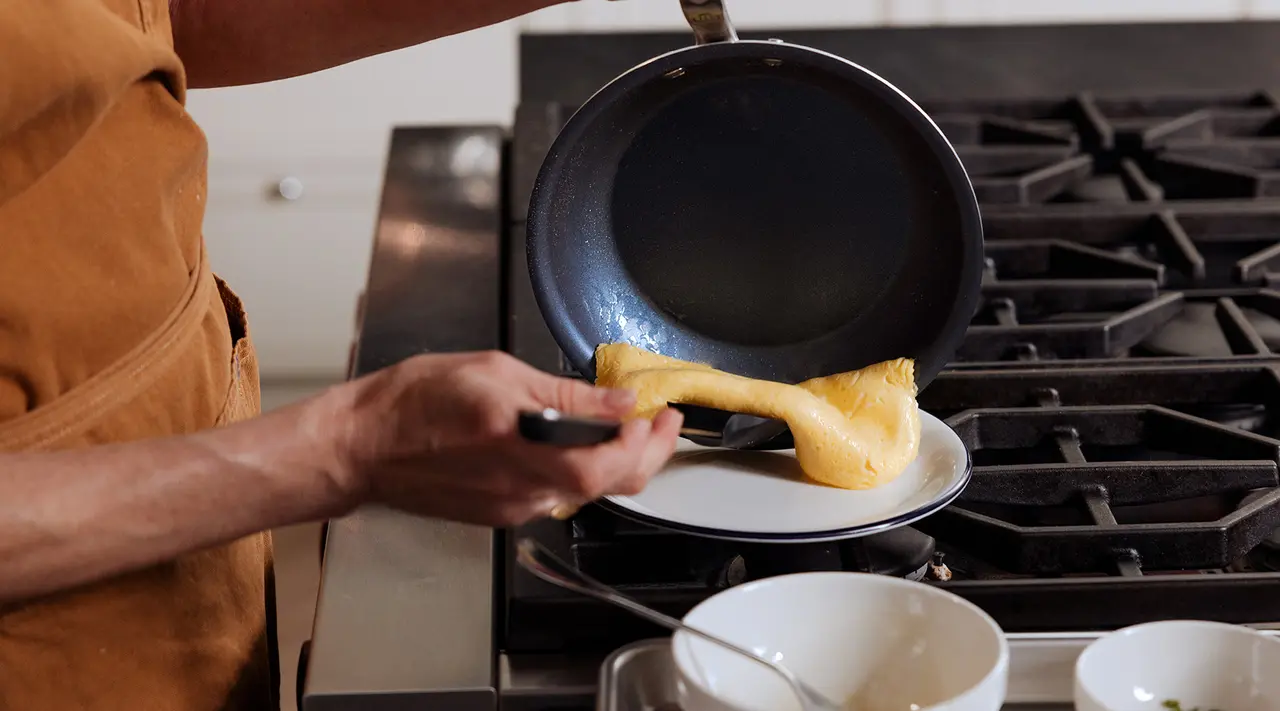
While there are certainly pros and cons to each material, when you get down to it, our Enameled Cast Iron Skillets and ProCoat Non Stick Frying Pans can’t really be compared. The two pieces serve as building blocks for a fully stocked kitchen, and complement each other in terms of their strengths and capabilities.
Where non stick is best for delicate cooking, enameled cast iron can handle anything from rustic pot pies to elegant roasted birds—and we think they're both absolute essentials in every kitchen.
If you’re looking to prepare dishes such as breakfast tostadas, you may want to consider a non stick skillet. For dishes like skillet roasted chicken, an enameled cast iron might be right for you at this time—but we can't overstate enough how essential we find both of these materials to be.
Ready to Shop?
Now that you know the difference between enameled cast iron and non stick skillets, it’s time to get shopping. Our Enameled Cast Iron Skillet is hand-enameled in France and oven safe up to 580F, and our ProCoat Non Stick features multiple layers of a durable, professional-quality non stick coating over our Award-Winning Stainless Clad base. Whether you get one or both, you're sure to see the difference chef-loved cookware can make.
